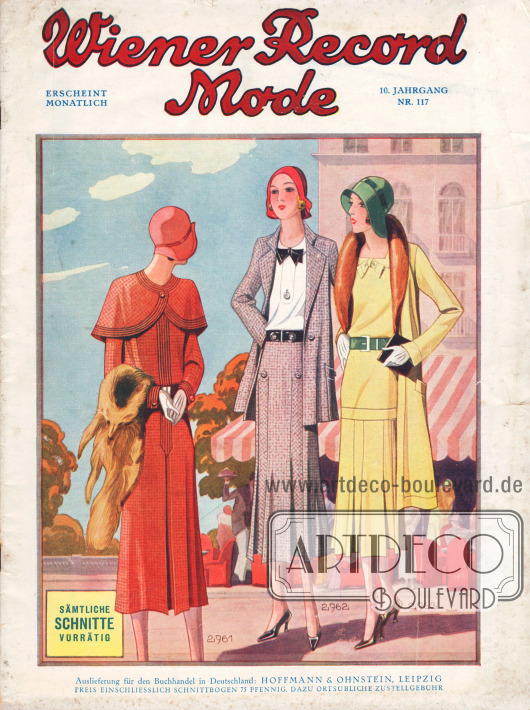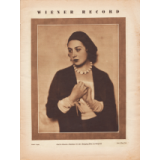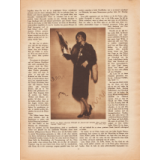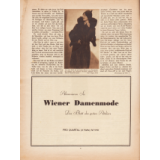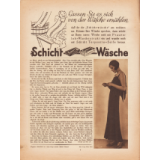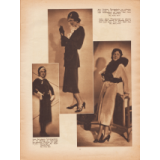|
P. 1 |
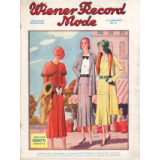
|
Front page, title page or cover of the Austrian illustrated women's and fashion magazine Wiener Record Mode (Eng. title: Viennese Record Fashion) no. 117 for August 1930.
PUBLISHED MONTHLY.
10TH VOLUME, NO. 117.
DESCRIPTION OF MODELS ON FIRST COVER:
2761. Transitional dress of plaid English wool fabric in belted style with deep pleats and small cape. Coarse decorative stitching serves as finery. (Fabric usage: English wool fabric 3.50 m at 140 cm width. Pattern size 44.)
2762. Transitional suit made of English wool fabric in a strictly sporty manner. Attached panels in staggered stripes provide the finery. Blouse in white crepe de chine. (Fabric usage: English wool fabric 3.50 m at 140 cm width, crepe de chine 2 m at 100 cm width. Pattern size 44.)
2763. Transitional ensemble of beige, fluffy wool fabric. Three-quarter length, strictly straight coat, collar of blond fur, long jumper with green leather belt. (Fabric usage: wool fabric 5.25 m at 130 cm width. Pattern size 44.)
ALL PATTERNS IN STOCK.
Delivery for the book trade in Germany: HOFFMANN & OHNSTEIN, LEIPZIG.
PRICE INCLUDING PATTERN SHEET 75 PFENNIGS, PLUS LOCAL DELIVERY CHARGE.
Drawing/illustration: unknown/unsigned.
[Page 1]
|
|
P. 2 |
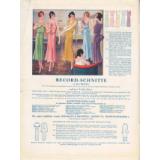
|
2764: Small evening dress in light green crepe de chine. The skirt has a scalloped cut at the bottom, a decorative trim arrangement, belt with jeweled buckle. (Fabric usage: crepe de chine 4 m at 100 cm width. Pattern size 42.)
2765: Small evening dress of pale pink crepe de chine. The dainty cape and belt are finished with bows. The skirt part, set in a zigzag line, forms loose pleats. (Fabric usage: crepe de chine 4.75 m at 100 cm width. Pattern size 42.)
2766: Youthful evening dress in lime-green crepe satin. The skirt features shaped set-in fabric pieces with rich smocking. A snappy bow completes the effect. (Fabric usage: crepe satin 4.25 m at 100 cm width. Pattern size 42.)
2767: Youthful evening dress in pastel crepe de chine in bloused, belted shape. Graceful cape, on the shoulder a floral arrangement. (Fabric usage: crepe de chine 5 m at 100 cm width. Pattern size 42.)
2768: Youthful evening dress in mauve faille with flouncy bolero in same color crepe georgette. The set-in hip yoke is finished with a large bow at the back. (Fabric usage: faille 5 m at 90 cm width, crepe georgette 1.25 m at 100 cm width. Pattern size 42.)
RECORD PATTERNS for all styles are immediately available in the indicated standard sizes with picture and designations on the individual pattern pieces at the following prices:
Large cuts GM. 1.— (dress, suit, coat). Small cuts GM. —.70 (skirt, blouse, children's dress). Patterns according to personal measurements GM. 4.— (complicated patterns 50% extra charge).
In case of written order the cheapest way to order is: deposit of the amount, plus GM. —.15 for postage to a post office checking account, mark the order on the same section, or send it in advance in stamps, plus GM. —.15 postage. In the case of cash on delivery, there will be an additional GM. —.30.
Prices of transfer patterns for our needlework patterns: Size I GM. —.75, size II GM. 1.30, size III GM. 1.80.
PATTERN STORES
in the following cities, available through Record sales office in:
Brunswick, Bohlweg 49, Heinrich Boennighausen.
Breslau 1, Goldstein & Rettig, Hintermarkt 2-3.
Dessau, Theaterbau, Joh. Rothe.
Dresden-A., Wallstrasse 12, Alwin Krause.
Elberfeld, Wallstrasse, Ph. Freudenberg.
Erfurt, Wenigemarkt 11, Franz Discher.
Frankfurt a. M., Stiftstrasse 35, Peter Schmitt.
Freiberg, Erbische Str. 2-4, Carl Hubricht.
Halle a. Saale, Or. Ulrichstrasse 6-8, W. F. Wollmer.
Hamburg, Heuberg 1, B. Meyer.
Hanover, Karmarschstraße 5, C. Westermann.
Kassel, Oberste Gasse 28, A. Waege.
Kiel, Fleethoern 7, C. Fries.
Cologne a. Rhine, Glockengasse 13, Heinr. Kramer.
Leipzig C 1, Hospitalstraße 2, Hoffmann & Ohnstein, telephone 10890.
Magdeburg, Schuhbruecke 10, Hans Kaufmann.
Mainz, Mittlere Bleiche 41, F. Schaudt.
Munich, Utzschneiderstrasse 9, H. Staudinger, telephone 20483.
Pforzheim, Goethestraße 16, Adam Sommer.
Regensburg, Stadtamhof, Tietz department store.
Wuerzburg, Kuerschnerhof, M. Ph. Seiser.
Where not available: through HOFFMANN & OHNSTEIN, LEIPZIG C 1 HOSPITALSTRASSE 2. Postal check account Leipzig no. 52.923.
Record patterns must be provided with picture, fabric calculation and stamping of the individual pattern parts; we ask that other fabrications be rejected.
[Page 2]
|
|
P. 4 |
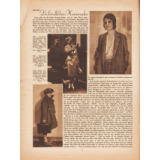
|
Article:
Kaus, Gina, The Hostile Comrades (authoress Gina Kaus, Austrian translator and screenwriter, 1895-1985).
There are three fashion photographs on the page that are not related to the article. The image captions read "Top: morning and traveling costume of white and black homespun, blouse of white georgette with black stitching, matching cap (Alice Brousch [possibly artist Alice Bronsch? 1910-1973]), model M. Gerstel," "Middle: Raincoat of medium blue silk rubber with medium blue, dark blue striped lining. Model Benedict" and "Bottom: Jaunty boy's coat for travel and sports made of brown, red and white nubby homespun. Model Arnold Mueller."
Photos: Becker & Maass, Berlin; Lili Baruch, Berlin (Auguste Lilly Marga Baruch, 1895-1966).
[Page] 4
|
|
P. 7 |
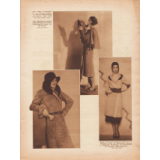
|
Three fashion photographs with the image explanations "Middle: Snappy transitional morning dress in mottled gray-pink lightweight wool fabric (Ilse Stobrawa [German actress, 1908-1987]). Model Klyhs", "Left: Autumn coat of brown-white homespun with brown caracul collar (Lu Basler [German actress, 1909-?]), model Benedict" as well as "Right: Very distinctive sporty ensemble for the seasonal transition from beige and dark brown homespun in interesting workmanship. As a belt fastener a riding whip. Model Schiaparelly [Sic!, Elsa Schiaparelli, note by M. K.]".
Photos: Becker & Maass, Berlin; Yva (Else Ernestine Neulaender-Simon, 1900-1942); Madame d'Ora, Paris (Dora Philippine Kallmus, 1881-1963).
[Page] 7
|
|
P. 10 |
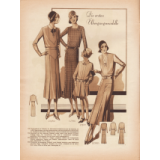
|
The first transitional models.
2789. Transitional dress in wool fabric, the waist yoke repeats the line of the ascot tie, a white lingerie collar, a snappy silk tie, and a button-trimmed panel frame the neck. (Fabric usage: 3.25 m at 130 cm wide.) Pattern size 44.
2790. Bolero dress of fine plaid wool fabric, wide belt, and buttons in same color leather. The different parts are cut in different layers of thread. (Fabric consumption: 3 m at 130 cm wide.) Pattern size 44.
2791. Girl's dress in wool fabric in bloused, belted style with full-length facings, patch pockets and buttons. (Fabric usage: 1.80 m at 130 cm wide.) Pattern size 8 to 10 years.
2792. Street dress of nubby wool fabric, wide facings mark a waist saddle and a bolero. Leather belt, vest of linen. (Wool fabric 3 m at 130 cm wide, linen 0.30 m at 80 cm wide.) Pattern size 44.
[Page 10]
|



